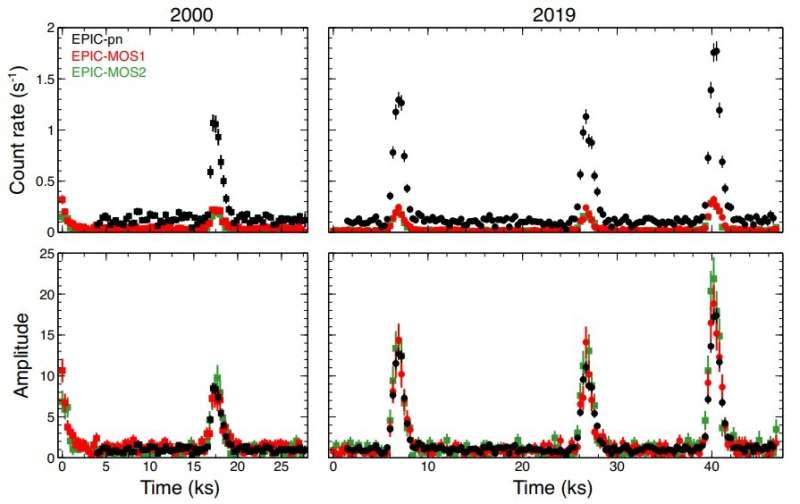Background-corrected light curves of RX J1301.9+2747, extracted with time bins of 300 s in the 0.2−2 keV band during the 10-11 December 2000 (left panels) and the 30-31 May 2019 (right panels) XMM-Newton observations. Bottom panels: the count rates have been normalised to the quiescent level. In black EPIC-pn, in red EPIC-MOS1, in green EPIC-MOS2 data. Credit: Giustini et al., 2020.
Astronomers have performed observations of a galaxy known as RX J1301.9+2747 using ESA's XMM-Newton spacecraft. The study unveiled three strong and rapid X-ray quasi-periodic eruptions (QPEs) in the nucleus of this galaxy. The finding is reported in a paper published February 20 on arXiv.org.
QPEs are defined as short, high amplitude quasi-periodic X-ray bursts over a stable flux level. They are observed as increases in the X-ray count rate over a quiescent level, and recur quasi-periodically. The name QPE was chosen to differentiate them from the gentler, quasi-sinusoidal modulation of the standard quasi-periodic oscillations (QPOs).
The first QPEs were detected in the galaxy GSN 069 during observation between December 2018 and February 2019. During the eruptions in this galaxy, the X-ray count rate increased by up to two orders of magnitude with event duration of just over one hour and recurrence time of about nine hours.
Searching for new QPEs, a team of astronomers led by Margherita Giustini of the Spanish Astrobiology Center in Madrid, Spain, took a closer look at RX J1301.9+2747—an edge-on post-starburst galaxy at a redshift of about 0.023 with properties potentially similar to those of GSN 069. RX J1301.9+2747 was observed in May 2019 using XMM-Newton, which resulted in the identification of new QPEs.
"During a 48-ks-long XMM-Newton observation performed on 30 and 31 May 2019, three strong QPEs lasting about half an hour each were detected in the light curves of RX J1301.9+2747," the paper reads.
According to the study, the merged spectrum of the newly detected QPEs in the nucleus of RX J1301.9+2747 looks like a thermal component with a temperature of about 100 to 300 eV. This component has a 0.2−2 keV intrinsic luminosity at a level of 10 tredecillion erg/s, what is about one order of magnitude higher than the luminosity of the quiescent level.
The astronomers write that the general properties of the three QPEs in RX J1301.9+2747 are similar to those of the QPEs detected in GSN 069. However, they are also some differences. For instance, QPEs in RX J1301.9+2747 are shorter than those in GSN 069, and their time separation is generally also shorter.
Furthermore, the researchers analyzed archival observational data of RX J1301.9+2747. As a result, they found evidence suggesting the presence of QPEs in this source for at least the past 18.5 years.
In concluding remarks, the astronomers noted that many questions regarding the origin and nature of QPEs remain unanswered. Hence, further monitoring of RX J1301.9+2747 and GSN 069 could be essential to better understand the QPE phenomena.
"The question whether QPEs are directly associated with accretion flow variability and/or instabilities or due instead to extrinsic phenomena (such as interactions with a secondary orbiting body) remains to be studied. Future X-ray observations of both sources will enable us to constrain possible theoretical models taking advantage of the different properties and timescales in the two sources, which need to be consistent with a similar theoretical framework," the authors of the paper wrote.
More information: X-ray quasi-periodic eruptions from the galactic nucleus of RX J1301.9+2747, arXiv:2002.08967 [astro-ph.HE]: arxiv.org/abs/2002.08967
© 2020 Science X Network
























